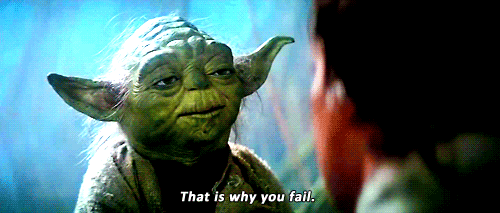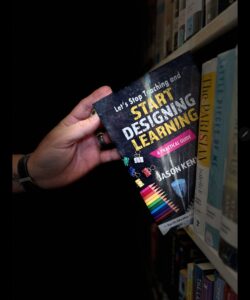I saw my first motion picture when I was 4 years old. It was The Empire Strikes Back. You might have heard of the franchise. It’s still around. Of all the Star Wars movies, I find that this one has the most one liners quoted by everyone. “Do or do not. There is no try.” from Yoda. Or Han Solo being the scoundrel he is by returning Leia’s “I love you,” with his iconic, “I know,” response. And finally, the continually misquoted, “No, I am your father,” by Vader himself.
For this post, I wanted to focus on the scene in the movie when Luke has been training on Dagobah with Master Yoda for some time. He’s struggled to say the least and has decided to leave before his training is complete. When attempting to raise his submerged ship from the swampy waters with his powers of the Force, Luke fails. This is when Yoda steps in. Raising his clawed hand, concentrating his power, and lifting the ship out and safely onto dry land, Yoda leaves Luke with only one thing to say as he stares at what Yoda just accomplished, “I don’t believe it.” Yoda’s response, short and to the point, is this: “That is why you fail.”
This got me thinking about what we do in schools. We may feel like we are stuck in a swamp. We’ve been training and learning and working so hard, using all of our knowledge and power to make change happen in the learning in the building. We try, see some progress, only to find things sinking back down in the muck. It’s not that we don’t have the ability to make success happen. It’s that we don’t believe. And there’s two things we MUST believe in: our kids and ourselves.
Belief in Kids’ Ability
I have written this before and will continue to until we, as educators, completely remove the following phrases from escaping our lips, “These kids can’t […]” Look, the whole point of education is not about the word “can’t.” It has never been about what the kids can’t do, but it’s always been about what they can do with the tools we give to them. That’s what school is about. The danger that comes when we say they “can’t” is that when we give that thought words, we are one step closer to believing they can’t. When we believe they can’t, then we will treat them as if they can’t, and then we lower the bar of expectations for their learning. At the end of the year, we sit back and scratch our heads in wonder of why they performed so poorly. If we think they are low, we will call them low, we will believe they’re low, we will treat them as low, and their performance will be low. We should have not expected anything else.
This is on us. We have to believe in the ability of all kids to learn at high levels. We do not lower the bar. Our job is to scaffold kids up, coach kids up, support kids up, train kids up, learn kids up to meet the bar. That’s our job. We find ways to get every kid there without any preconceived notion about their ability other than the belief that they can get to grade level proficiency with our help. We use data to find out where they are, so we can map out how we will get them there. We don’t use the data to slap a label on them that eventually seeps into how we think, believe or treat them as learners. Believe they can learn with your help!
Belief in Kids’ Attitude
We also need to believe that kids want to do well while they are with us in the classroom. The Quaglia Institute Survey includes results from over a half a million U.S. students across the majority of states where kids have told us how they feel about school and learning. Over 85% of 3-12 students say they want and are trying to do their best while they are at school. Additionally, looking at any other item on the survey that centers on kids’ attitude towards their effort and motivation, you will find that all responses are 80% or higher. But then, so many times we hear an adult say, “These kids won’t […]” They are saying they want to, but we’re saying they won’t? Somewhere there is a disconnect.
Some of that disconnect may lie in other responses on the survey. Perhaps our perception of kids not wanting to do their best in school is equally matched with another perception. Perhaps kids see school as a place that isn’t that engaging or welcoming. When responding to statements like, “School inspires me to learn,” “I am recognized when I do my best,” or other statements related to belonging or being engaged while at school, learners’ responses were in the low 40% – 60% range. Again, this is their perception which may help explain our perception of their attitude when it comes to learning. The choice we have is to either keep on doing what we’ve always done and expect the kids to change, or find ways to answer their perception of school with changes on our part to make it more engaging and welcoming.
Belief in Our Ability
This is where the belief in our ability comes into play. We have all the answers in the building. There is so much potential and professional knowledge in the walls of each school that I am certain there is no issue that cannot be met and solved through our collective commitment and collaboration. We can come together and design for engagement (not entertainment) to happen. We can collaborate to discover innovative methods to meet the needs of all learners. Innovative methods, that given time and testing enough, will eventually become best practices. We know our kids, we know what works, we know working together works best. We have the ability to solve nearly all of our own “problems,” and when we can’t, we know that we have the ability to go out and find the answers.
Too often we want to run to a program or a new textbook to help. New resources are great and can help inspire and motivate us as educators at times. However, the reason a teacher will always be better than a program, textbook or packed product is that the teacher knows the learners in the room. The company you paid for these resources does not. Take your state standards which ARE your curriculum. They are WHAT you teach. Decide what your learners will NOT leave you without mastering. Take what you know about WHO you teach, your learners. Add to both what science says about learning and HOW learning works. Now, you have a final product, how you will teach.
Belief in Our Agency
Some might say, “What can I do? I’m just a teacher.” This is when we have to believe in our ability to make things happen as agents of change. We have to believe that despite what might be happening in our school or happening in the homes of our learners we have the ability to make a positive impact on learning. I know it is easy to feel defeated at times. We look at the circumstances and say, “Well, I’ll be able to make a change when ________ happens first.” It’s easy to look at the mess, point out that we didn’t create it in the first place, and continue to blame. But blame doesn’t get change to happen. And we want that change, for ourselves and our kids. What gets change to happen? Change in ourselves.
We have to believe that we have the ability to change things in our classrooms and schools for the better through our commitment to the mission. The mission of learning. We see the circumstances and can sit in them for a moment, but the mission requires us to act. And our main action is to become agents of change. We change, those changes beget other changes. Changes in our kids, changes in our colleagues. Change is as contagious as it is confrontational. The point is this, we control the change. We make the change we want to see in our kids and in each other. That can start with one teacher, one classroom, one school. We are all change agents who have the ability to improve what we do for learning, benefiting our kids and ourselves.
We can sit back in disbelief, inaction and judgment when we are faced with all the things we are faced with. If we continue not to believe, we’ll stay stuck in the swamp. But, we have a force so powerful that when we come together and use it, nothing can stand in the way of getting the improvement we want to see. It is belief. Belief in our kids and belief in ourselves. Believe it.


